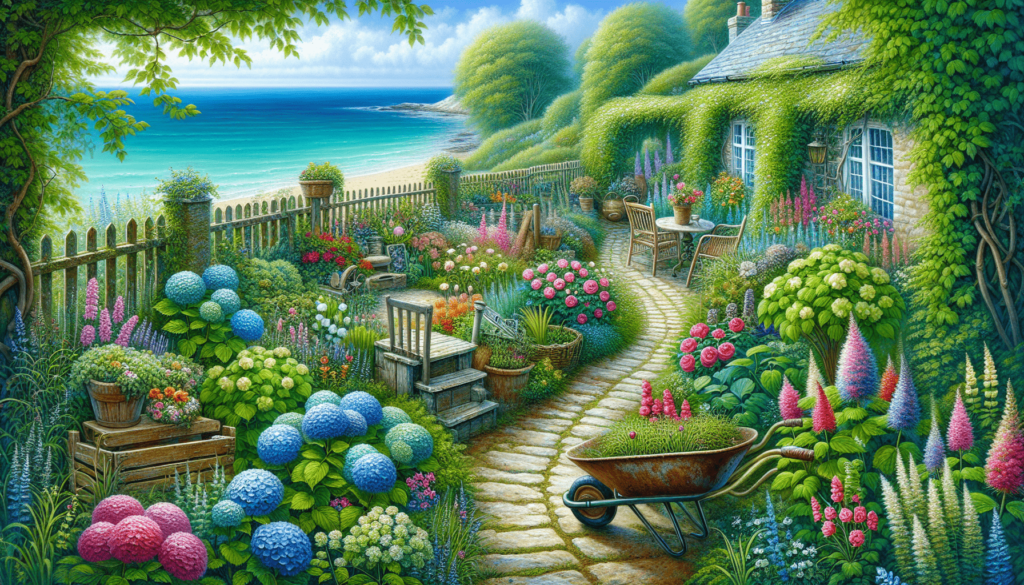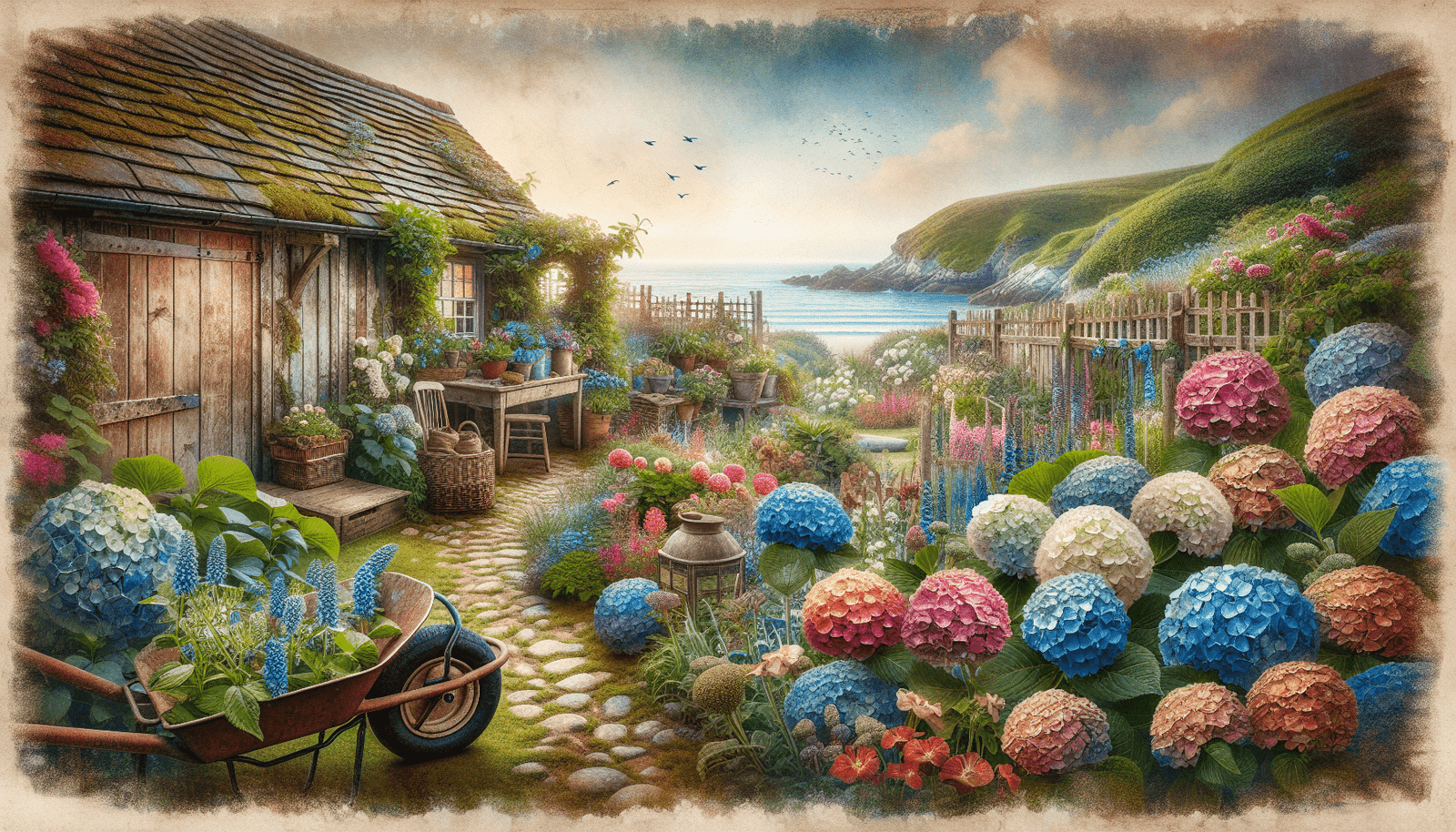Have you ever dreamed of creating a serene and charming coastal cottage garden right in your own backyard? In this article, we will guide you through the art of designing and cultivating a coastal cottage garden that exudes relaxation and beauty. Let’s get started on transforming your outdoor space into a tranquil oasis that captures the essence of coastal living.

Understanding the Coastal Cottage Garden Aesthetic
Picture this: a garden filled with an abundance of colorful blooms, lush greenery, and the soothing sound of waves crashing nearby. This is the essence of a coastal cottage garden. Incorporating elements of seaside living, such as natural textures, breezy vibes, and a relaxed feel, this type of garden brings a touch of the beach to your home.
In a coastal cottage garden, the goal is to create a space that is both visually appealing and functional. From romantic roses to rugged driftwood accents, every element in the garden should work together to evoke a sense of coastal charm.
Key Elements of a Coastal Cottage Garden
A coastal cottage garden is a harmonious blend of plant life, hardscape features, and decorative accents that come together to create a tranquil and inviting outdoor space. Here are some key elements to consider when designing your coastal cottage garden:
-
Native Plants: Choose plants that thrive in coastal environments, such as lavender, rosemary, and succulents. These hardy plants can withstand salt spray and sandy soil, making them ideal choices for a coastal cottage garden.
-
Seaside Accents: Incorporate elements that reflect the coastal theme, such as driftwood, seashells, and pebbles. These natural materials add texture and interest to the garden, enhancing its beachy vibe.
-
Color Palette: Stick to a soft and soothing color palette inspired by the sea, such as shades of blue, white, and soft pastels. These calming colors create a sense of tranquility and serenity in the garden.
-
Relaxed Design: Opt for a relaxed and informal design that mimics the carefree nature of beach living. Allow plants to spill over pathways, create cozy seating areas, and embrace a slightly wild and untamed look in your garden.
By incorporating these key elements into your design, you can create a coastal cottage garden that embodies the laid-back charm of seaside living.
Planning Your Coastal Cottage Garden Layout
Before you start planting, it’s important to carefully plan out the layout of your coastal cottage garden. Consider factors such as sunlight exposure, soil conditions, and proximity to the ocean when designing your garden space.
Soil Quality and Drainage
The first step in planning your garden layout is to assess the soil quality and drainage in your outdoor space. Coastal environments often have sandy soil that drains quickly, so it’s important to choose plants that can thrive in these conditions.
Consider conducting a soil test to determine the pH level and nutrient content of your soil. Amend the soil as needed to ensure that it provides a healthy growing environment for your plants.
Sunlight Exposure
Another key factor to consider when planning your garden layout is sunlight exposure. Most coastal cottage plants thrive in full sun, so be sure to select a location that receives at least 6-8 hours of sunlight per day.
Take note of any areas of shade or partial shade in your garden space and plan accordingly by selecting plants that can tolerate these light conditions.
Proximity to the Ocean
If you live close to the ocean, it’s important to consider the effects of salt spray on your plants. Choose salt-tolerant plants that can withstand exposure to salty air and strong winds.
Position delicate plants in sheltered areas of your garden to protect them from the harsh coastal elements. Consider installing windbreaks or barriers to shield your plants from salt spray and wind damage.
By carefully planning the layout of your coastal cottage garden, you can create a thriving and beautiful outdoor space that is tailored to the unique conditions of your coastal environment.
Selecting Plants for Your Coastal Cottage Garden
Choosing the right plants is essential to creating a successful coastal cottage garden. Opt for hardy, low-maintenance plants that can withstand the challenges of coastal living, such as salt exposure, high winds, and sandy soil.
Coastal Cottage Garden Plants
Here are some popular plants that are well-suited to coastal cottage garden settings:
| Plant | Description |
|---|---|
| Lavender | Fragrant herb with purple flowers |
| Rosemary | Aromatic herb with delicate blue flowers |
| Hydrangea | Deciduous shrub with large, showy blooms |
| Sea Holly | Spiky, blue flowers on a rugged plant |
| Blanket Flower | Bright and cheerful daisy-like blooms |
These plants not only thrive in coastal conditions but also add beauty and color to your garden. Mix and match different plant varieties to create a diverse and visually appealing landscape that captures the essence of a coastal cottage garden.
Incorporating Native Plants
When selecting plants for your coastal cottage garden, consider incorporating native species that are well-adapted to your local climate and soil conditions. Native plants are better equipped to handle the challenges of coastal living and require less maintenance and water, making them a sustainable choice for your garden.
Research native plant species that are suited to your area and incorporate them into your garden design for a natural and harmonious look.
Drought-Tolerant Plants
In coastal environments, water conservation is key. Choose drought-tolerant plants that require minimal watering and can thrive in sandy, well-drained soil. Succulents, ornamental grasses, and Mediterranean herbs are excellent choices for a low-maintenance coastal garden.
By selecting plants that are well-suited to your coastal environment, you can create a beautiful and sustainable garden that will thrive for years to come.
Creating Hardscape Features in Your Coastal Cottage Garden
In addition to plants, hardscape features play a crucial role in defining the aesthetic and functionality of your coastal cottage garden. From pathways to seating areas, incorporating hardscape elements adds structure and interest to your outdoor space.
Pathways and Walkways
Create meandering pathways that wind through your garden, inviting you to explore and enjoy the beauty of your coastal surroundings. Use natural materials such as gravel, crushed shell, or stepping stones to create a casual and beachy feel.
Enhance your pathways with fragrant herbs, such as thyme or mint, that release a delightful aroma as you walk through the garden. Add seating areas along the pathways to provide tranquil spots for relaxation and contemplation.
Coastal-Inspired Decor
Infuse your garden with coastal charm by incorporating decorative accents that reflect the seaside theme. Hang wooden signs with beachy quotes, display seashell wind chimes, or add a driftwood bench for a touch of rustic elegance.
Consider repurposing old nautical items, such as sailor’s rope or weathered buoys, as unique and whimsical garden decor. These quirky touches add personality and character to your coastal cottage garden.
Water Features
Bring the soothing sound of the ocean to your garden with a water feature, such as a fountain, pond, or birdbath. The gentle trickle of water adds a sense of tranquility to your outdoor space and attracts birds and other wildlife to your garden.
Position water features strategically to create focal points and enhance the overall ambiance of your coastal cottage garden. Choose a design that complements the coastal theme, such as a shell-shaped fountain or a driftwood-lined pond.
By incorporating hardscape features into your garden design, you can create a cohesive and visually appealing outdoor space that complements the natural beauty of your coastal surroundings.

Maintaining Your Coastal Cottage Garden
Once you’ve designed and planted your coastal cottage garden, it’s important to maintain and care for your plants to ensure they thrive in their seaside setting. Regular maintenance tasks, such as watering, pruning, and fertilizing, will help keep your garden looking healthy and vibrant.
Watering and Irrigation
In a coastal environment, plants may need supplemental watering, especially during dry spells or periods of high winds. Monitor the moisture levels in your garden and adjust your watering schedule as needed to ensure that your plants receive an adequate amount of water.
Consider installing a drip irrigation system to deliver water directly to the roots of your plants, minimizing water waste and promoting healthy growth. Mulch around plant beds to retain soil moisture and reduce evaporation.
Pruning and Deadheading
Regular pruning and deadheading help maintain the health and appearance of your plants, promoting new growth and flowering. Remove dead or diseased branches, spent flowers, and overgrown foliage to improve air circulation and prevent pest and disease problems.
Prune shrubs and hedges to maintain their shape and size, and remove any damaged or crossing branches. Deadhead flowering plants to encourage continuous blooming and keep your garden looking fresh and tidy.
Fertilizing and Feeding
Feed your plants regularly with a balanced fertilizer to replenish nutrients in the soil and promote healthy growth. Choose a slow-release fertilizer that provides a steady supply of nutrients over time, minimizing the risk of nutrient leaching into coastal waters.
Avoid over-fertilizing, as this can lead to nutrient runoff and water pollution. Follow the manufacturer’s instructions for proper application rates and timing to ensure that your plants receive the nutrients they need without causing harm to the environment.
By following these maintenance tips and practices, you can keep your coastal cottage garden looking vibrant and thriving year-round, creating a beautiful and relaxing outdoor retreat right in your own backyard.
Conclusion
Designing and creating a coastal cottage garden is a rewarding and fulfilling experience that allows you to connect with nature and bring the beauty of the seaside to your home. By incorporating native plants, seaside accents, and hardscape features, you can design a garden that captures the essence of coastal living and provides a peaceful retreat for relaxation and enjoyment.
Whether you’re a seasoned gardener or a beginner looking to try your hand at gardening, creating a coastal cottage garden is a fun and creative project that allows you to express your personal style and nurture the beauty of your outdoor space. With careful planning, plant selection, and maintenance, you can transform your backyard into a coastal oasis that will delight your senses and soothe your soul. Happy gardening!

